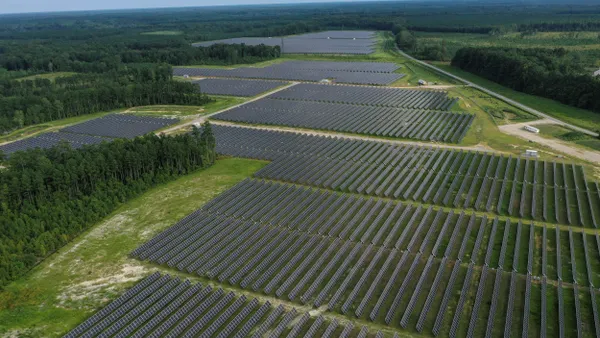Dive Brief:
- Rooftop solar generation delivers benefits to all Nevada utility customers, regardless of whether or not they own a distributed solar system, according to a new report from SolarCity and the Natural Resources Defense Council.
- Using a public tool devised by regulators to assess distributed solar, the paper reports that rooftop arrays deliver 1.6 cents in net benefits to the ratepayer base for every kWh generated. When environmental benefits are included, the number increases to $0.036/kWh.
- Current regulatory analyses do not capture the entire spectrum of grid benefits from rooftop solar, the company said, and it provided details of its study methodology "in hopes that it will inform policy and regulatory discussions on the value of solar and DERs."
Dive Insight:
Determining the value of distributed solar is a slippery subject, especially in Nevada.
The Public Utilities Commission of Nevada (PUCN) came under fire last year when they approved a controversial net metering policy that reduced the net metering retail rate credits for residential rooftop solar users and excluded a grandfathering provision for existing users.
In January, when the PUCN considered allowing existing rooftop solar customers to keep their retail rate net metering credits, commission staff estimated that the move would result in a subsidy to solar customers of up to $160 million at the expense of the rest of the rate base.
That finding echoed similar analyses from NV Energy, which has repeatedly argued before regulators that solar ratepayers are subsidized by other customers to the tune of millions of dollars a year.
But according to SolarCity, those findings on solar's value to Nevada have been incomplete.
"While a net cost would indicate that NEM is providing a subsidy to solar, our results conclude that the opposite is true: rooftop solar provides a net benefit to all Nevadans in the range of 1.6 to 3.4 cents per kilowatt-hour (kWh) of solar production," the company wrote in the executive summary of its new study.
"Assessing this full set of ongoing costs and benefits from the roughly 257 megawatts (MW) of existing NEM solar systems already deployed or in the pipeline in Nevada, we calculate a net value of $7-14 million per year to all Nevadan utility customers," the company said.
The difference between the new study and previous assessments of solar value has to do with what reserchers sought to measure, SolarCity said.
The new report assessed solar using 11 different benefit variables laid out by the PUCN in its Public Tool, a spreadsheet-based tool used to quantify the costs and benefits of distributed solar. Previous analyses, specifically the one that predicated the Dec. 2015 order to end retail rate net metering, did not look at all the factors, according to the report's executive summary.
"[I]n December 2015, the [PUCN] stated in their NEM tariff order that 'For other than the avoided energy and energy losses/line losses, there is insufficient time or data in this proceeding to assign a value to the other nine [benefit] variables,'" researchers wrote. "Going forward, we offer our analysis as a resource to assign values to the 'other nine variables' identified by the PUCN."
When those benefits, including factors like ancillary services and T&D capacity, are figured in, the researchers found the benefits to the grid to be higher than previous analyses:
Along with the report, SolarCity released recommendations for "industry stakeholders to consider as we transition to a cleaner, more affordable and resilient grid." They include using the expanded benefit and cost categories for future distributed solar decisions, removing utility disincentives to distributed energy growth and modernizing grid planning processes.
The SolarCity study, while it used the public tool, is unlikely to sit well with NV Energy and its allies in the state. Last month, a nonprofit group supported by the utility launched a new ad campaign arguing net metering "forces Nevada families to pay higher bills to subsidize rooftop solar" and calling the incentive program "a government subsidy with no limits that would go up and up and up."













